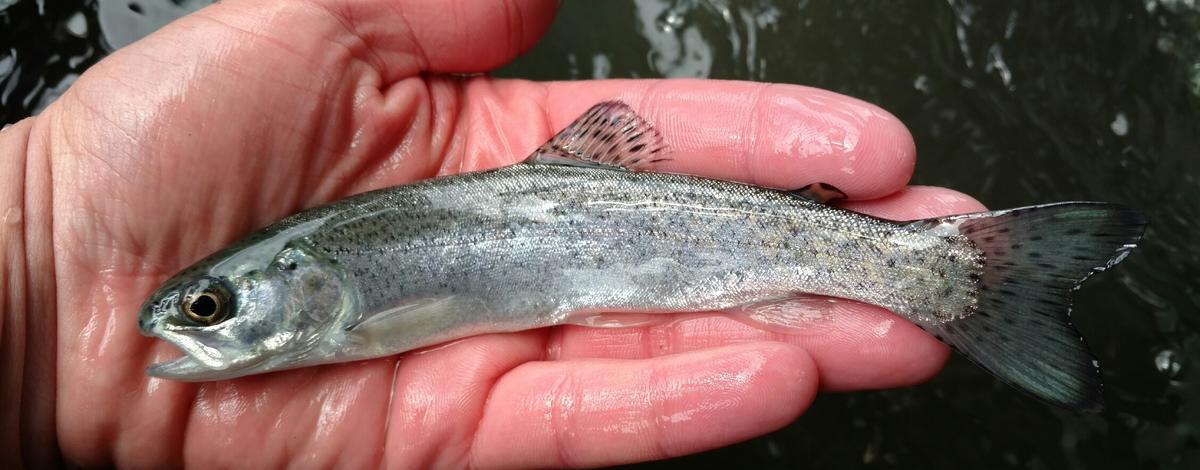Fisheries biologists use funny words sometimes when describing a fish’s life. Biologists who work with salmon and steelhead often talk about smolts. So, what exactly is a smolt?
Smolt, not smelt
The word ‘smolt’ comes from Old English (smeolt). It had several meanings like calm, gentle, smooth but also bright or shining. ”Bright or shiny” definitely describes a young migrating salmon and steelhead. The word ‘smolt’ is similar to the word ‘smelt’, meaning extracting metal from rock by heating and melting or meaning species of small silvery fish that live in both ocean and freshwater. By chance, the fish species called smelts are often distantly related to salmon.

A wild steelhead smolt. The rainbow color and vertical bars of a stream-dwelling fish have faded to silver.
In practical terms, a smolt is a young salmon or trout that is moving from freshwater to the ocean. Along the way, they change from living in a stream to living in the saltwater of the open ocean. The radical change in environment is accompanied by changes in the young fish. We see the signs every spring as a big pulse of smolts leaves Idaho in April and May. Salmon and steelhead may start the process while still in Idaho but won’t complete it until reaching the Pacific Ocean.
A critical transition to survive and thrive in saltwater
Several things happen as a young salmon or steelhead becomes a smolt. A series of changes occur that move the fish downstream and get them ready to enter saltwater. Like becoming a teenager, becoming a smolt demands energy and is stressful. Silvery pigment is deposited in the skin that covers previous markings and the tail becomes thinner and longer. The fish orient downstream and begin to migrate. In hatcheries, young salmon switch from congregating near the inflow to near the outflow.
The most radical change happens in the cells of the gills and kidneys where the mechanisms for moving fluid completely reverse direction to prepare for life in saltwater, because the ocean is saltier than a fish’s body. All these separate steps are coordinated by the thyroid gland, based on cues the fish receives from its environment.
The smolting process is set up by growth the previous year, triggered by increasing day length, and affected by moon phase, too. Lack of a necessary cue can derail the process and the fish stop migrating and may die. For example, fish not ready for saltwater when they reach the ocean may run out of energy and become easy prey for predators.

Two young Chinook salmon. The top fish has the color of an ocean-going smolt while the bottom is colored to blend into a stream bottom.
Following chemical bread crumbs
Becoming a smolt marks an important event in a salmon’s or steelhead’s life. They are moving to the ocean where they will gain 90% of their adult size. As they travel, the smolts remember the chemical smells of the waters where they hatched and all along the way downstream. This allows them to find their way back when they return as an adult. Because their movements are predictable in timing, smolts are an important stage to study. Most hatchery salmon and steelhead in Idaho are released as smolts so they have best chance at surviving to reach the ocean. Studying smolts can tell us how many are successfully leaving Idaho, which is an important part of understanding the health of our salmon and steelhead. That is why fisheries biologists say ‘smolt’ so often!
Check out the wild salmon and steelhead page for more articles about the science behind conserving Idaho’s wild salmon and steelhead.



